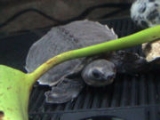
List of Testudines families
Encyclopedia
There are 14 extant families
of the order
Testudines, an order of reptile
commonly known as turtles, tortoise
s and terrapin
s. The testudines are some of the most ancient reptiles alive, with only the tuatara
s considered more primitive. There are approximately 300 extant species and 97 genera
of testudines, split into two suborders: the Cryptodira
ns and the Pleurodira
ns. The distinction between these two suborders is based on the mode in which they cover their head and neck. The Pleurodirans, also called the side-necked turtles, have long necks, and fold them sideways to align them with the shell. The Pelomedusidae
and Chelidae
are the only extant families of pleurodires. The Cryptodirans pull their neck straight back to conceal their head within the shell. The Carettochelyidae, Cheloniidae
, Chelydridae
, Dermatemydidae, Dermochelyidae
, Emydidae
, Kinosternidae
, Testudinidae and Trionychidae
are all cryptodires, although the ability to retract the head has been lost in the sea turtles (Cheloniidae and Dermochelyidae). A third order, the Paracryptodira
ns, are extinct.
Reptiles are classified according to the pattern of fenestration in the temporal region of the skull
. Testudines are placed in the subclass Anapsida because they lack fenestration. There are suggestions that this lack of fenestration is a secondary characteristic and that turtles belong in Diapsida.
Both sides cite strong evidence, and the conflict has yet to be resolved. The shell of testudines distinguishes them from other vertebrates. The shell is not an exoskeleton
, but a modified ribcage and part of the vertebral column
. Because of the shell, the pectoral and pelvic girdles are located within the ribcage. The limb bones are also modified to accommodate to the shell.
The earliest known turtles are from fossils in the Upper Triassic. These fossils are nearly indistinguishable from modern turtles anatomically. In these early fossils (mostly of the genus Proganochelys
), the teeth have already been lost, and a keratin
beak is suggested by the mandible
s. Important differences between Proganochelys and modern turtles are the presence of the palatal teeth (lost in modern species), the inability to retract the head within the shell, and the lack of a trochlear pulley in the jaw closing anatomy.
|-
|Emydidae
Rafinesque
, 1815||12||Pond or water turtles||Red-eared slider
(Trachemys scripta elegans)||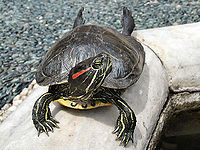 |-
|-
|Geoemydidae
Theobald
, 1868||24||Asian river, leaf, roofed or Asian box turtles||Malayan box turtle
(Cuora amboinensis)|| |-
|-
|Kinosternidae
Agassiz
, 1857||4||Mud or musk turtles||Common musk turtle
(Sternotherus odoratus)||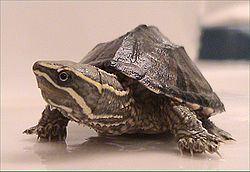 |-
|-
|Platysternidae
Gray
, 1869 ||1||Big-headed turtle||Big-headed turtle
(Platysternon megacephalum)||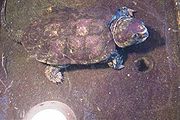
|-
|Testudinidae
Batsch
, 1788||12||Tortoises||Aldabra giant tortoise
(Geochelone gigantea)||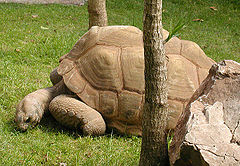 |-
|-
|Trionychidae
Fitzinger
, 1826||14||Softshell turtles||Spiny softshell turtle
(Apalone spinifera)||
|-
|colspan="5" align="center" |Pleurodira
– 3 families, 16 genera, over 60 species
|-
!Family!!Genera!!Common names!!Example species!!Example image
|-
|Chelidae
Gray
, 1831 ||15||Austro-American sideneck turtles||Common snakeneck turtle
(Chelodina longicollis)|| |-
|-
|Pelomedusidae
Cope
, 1868 ||2||Afro-American sideneck turtles||African helmeted turtle
(Pelomedusa subrufa)||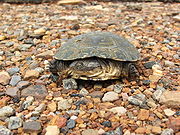 |-
|-
|Podocnemididae
Gray
, 1869 ||3||Madagascar big-headed, Big-headed Amazon River turtle and South American sideneck river turtles||Madagascar big-headed turtle (Erymnochelys madagascariensis)||
|}
Family (biology)
In biological classification, family is* a taxonomic rank. Other well-known ranks are life, domain, kingdom, phylum, class, order, genus, and species, with family fitting between order and genus. As for the other well-known ranks, there is the option of an immediately lower rank, indicated by the...
of the order
Order (biology)
In scientific classification used in biology, the order is# a taxonomic rank used in the classification of organisms. Other well-known ranks are life, domain, kingdom, phylum, class, family, genus, and species, with order fitting in between class and family...
Testudines, an order of reptile
Reptile
Reptiles are members of a class of air-breathing, ectothermic vertebrates which are characterized by laying shelled eggs , and having skin covered in scales and/or scutes. They are tetrapods, either having four limbs or being descended from four-limbed ancestors...
commonly known as turtles, tortoise
Tortoise
Tortoises are a family of land-dwelling reptiles of the order of turtles . Like their marine cousins, the sea turtles, tortoises are shielded from predators by a shell. The top part of the shell is the carapace, the underside is the plastron, and the two are connected by the bridge. The tortoise...
s and terrapin
Terrapin
A terrapin is a turtle living in fresh or brackish water.Terrapin may also refer to:* Terrapin , a transport vehicle used for amphibious assault by the Allies during the Second World War...
s. The testudines are some of the most ancient reptiles alive, with only the tuatara
Tuatara
The tuatara is a reptile endemic to New Zealand which, though it resembles most lizards, is actually part of a distinct lineage, order Sphenodontia. The two species of tuatara are the only surviving members of its order, which flourished around 200 million years ago. Their most recent common...
s considered more primitive. There are approximately 300 extant species and 97 genera
Genera
Genera is a commercial operating system and development environment for Lisp machines developed by Symbolics. It is essentially a fork of an earlier operating system originating on the MIT AI Lab's Lisp machines which Symbolics had used in common with LMI and Texas Instruments...
of testudines, split into two suborders: the Cryptodira
Cryptodira
Cryptodira is the taxonomic suborder of Testudines that includes most living tortoises and turtles. Cryptodira differ from Pleurodira in that they lower their necks and pull the heads straight back into the shells; instead of folding their necks sideways along the body under the shells' margins...
ns and the Pleurodira
Pleurodira
The Pleurodira are one of the two living suborders of turtles, the other being the Cryptodira. In many cases in the nomenclature of animals, ranks such as suborder are considered of little importance apart from nomenclatural or taxonomic reasons. However, this is not the case with the suborders of...
ns. The distinction between these two suborders is based on the mode in which they cover their head and neck. The Pleurodirans, also called the side-necked turtles, have long necks, and fold them sideways to align them with the shell. The Pelomedusidae
Pelomedusidae
Pelomedusidae is a family of freshwater turtles, native to eastern and southern Africa. They range in size from to in shell length, and are generally roundish in shape...
and Chelidae
Chelidae
The Chelidae are one of the three living families of the turtle suborder Pleurodira and are commonly called the Austro-South American Side Neck turtles. The Family is distributed in Australia, New Guinea, parts of Indonesia and throughout most of South America. It is a large family of turtles with...
are the only extant families of pleurodires. The Cryptodirans pull their neck straight back to conceal their head within the shell. The Carettochelyidae, Cheloniidae
Cheloniidae
Cheloniidae is a family of turtles belonging to the sea turtle superfamily Chelonioidea.-Extant genera:*Genus Caretta**Loggerhead sea turtle *Genus Chelonia**Green sea turtle *Genus Eretmochelys...
, Chelydridae
Chelydridae
Chelydridae is a family of turtles which has seven extinct and two extant genera. The extant genera are Chelydra the snapping turtles, and its larger relative Macrochelys, of which the Alligator Snapping Turtle is the only species. Both are endemic to the Western Hemisphere...
, Dermatemydidae, Dermochelyidae
Dermochelyidae
Dermochelyidae is a family of turtles which has eight extinct and one extant genera.-Classification of known genera:*Subfamily Desmatochelyinae** Corochelys ** Desmatochelys *Subfamily Allopleuroninae ** Allopleuron ** Eosphargis...
, Emydidae
Emydidae
Emydidae, commonly called the pond turtles or marsh turtles, is a family of turtles. Previously, several species of Asian box turtle were classified in the family. However, revised taxonomy has separated them to a different family. Now, Emydidae, with the exception of two species of pond turtle,...
, Kinosternidae
Kinosternidae
Kinosternidae is a family of mostly small turtles that includes the mud turtles and musk turtles. The family Kinosternidae contains 25 species within 4 genera, but taxonomic reclassification is an ongoing process so many sources vary on the exact numbers of species and subspecies...
, Testudinidae and Trionychidae
Trionychidae
Trionychidae is a taxonomic family which comprises a number of turtle genera commonly known as softshells. They are also sometimes called pancake turtles. Softshells consist of some of the world's largest fresh water turtles, though many can adapt to living in highly brackish areas. Members of this...
are all cryptodires, although the ability to retract the head has been lost in the sea turtles (Cheloniidae and Dermochelyidae). A third order, the Paracryptodira
Paracryptodira
The Paracryptodira are an extinct infraorder of the Testudines, an order of reptiles which includes tortoises, turtles and terrapins. Initially treated as suborder sister to the Cryptodira, they are now known to be a very primitive lineage inside the Cryptodira according to the most common use of...
ns, are extinct.
Reptiles are classified according to the pattern of fenestration in the temporal region of the skull
Skull
The skull is a bony structure in the head of many animals that supports the structures of the face and forms a cavity for the brain.The skull is composed of two parts: the cranium and the mandible. A skull without a mandible is only a cranium. Animals that have skulls are called craniates...
. Testudines are placed in the subclass Anapsida because they lack fenestration. There are suggestions that this lack of fenestration is a secondary characteristic and that turtles belong in Diapsida.
Both sides cite strong evidence, and the conflict has yet to be resolved. The shell of testudines distinguishes them from other vertebrates. The shell is not an exoskeleton
Exoskeleton
An exoskeleton is the external skeleton that supports and protects an animal's body, in contrast to the internal skeleton of, for example, a human. In popular usage, some of the larger kinds of exoskeletons are known as "shells". Examples of exoskeleton animals include insects such as grasshoppers...
, but a modified ribcage and part of the vertebral column
Vertebral column
In human anatomy, the vertebral column is a column usually consisting of 24 articulating vertebrae, and 9 fused vertebrae in the sacrum and the coccyx. It is situated in the dorsal aspect of the torso, separated by intervertebral discs...
. Because of the shell, the pectoral and pelvic girdles are located within the ribcage. The limb bones are also modified to accommodate to the shell.
The earliest known turtles are from fossils in the Upper Triassic. These fossils are nearly indistinguishable from modern turtles anatomically. In these early fossils (mostly of the genus Proganochelys
Proganochelys
Proganochelys quenstedti is the second oldest turtle species discovered to date, known only from fossils found in Germany and Thailand in strata from the late Triassic, dating to approximately 210 million years ago...
), the teeth have already been lost, and a keratin
Keratin
Keratin refers to a family of fibrous structural proteins. Keratin is the key of structural material making up the outer layer of human skin. It is also the key structural component of hair and nails...
beak is suggested by the mandible
Mandible
The mandible pronunciation or inferior maxillary bone forms the lower jaw and holds the lower teeth in place...
s. Important differences between Proganochelys and modern turtles are the presence of the palatal teeth (lost in modern species), the inability to retract the head within the shell, and the lack of a trochlear pulley in the jaw closing anatomy.
Families
The following lists the family—the Latin name of the family, date in which the species was formally described and classified, and the binomial authority on the species; the number of genera belonging to the family; the name or names commonly used; an example species and an example image.| Cryptodira Cryptodira Cryptodira is the taxonomic suborder of Testudines that includes most living tortoises and turtles. Cryptodira differ from Pleurodira in that they lower their necks and pull the heads straight back into the shells; instead of folding their necks sideways along the body under the shells' margins... – 11 families, 74 genera, over 200 species |
||||
| Family | Genera | Common name(s) | Example species | Example image |
|---|---|---|---|---|
| Carettochelyidae Boulenger George Albert Boulenger George Albert Boulenger FRS was a Belgian-British zoologist who identified over 2000 new animal species, chiefly fish, reptiles and amphibians.-Life:... , 1887 |
1 | Pig-nosed turtle | Pig-nosed turtle (Carettochelys insculpta) | 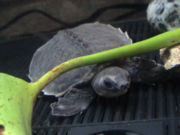 |
| Cheloniidae Cheloniidae Cheloniidae is a family of turtles belonging to the sea turtle superfamily Chelonioidea.-Extant genera:*Genus Caretta**Loggerhead sea turtle *Genus Chelonia**Green sea turtle *Genus Eretmochelys... Oppel Nicolaus Michael Oppel Nicolaus Michael Oppel was a German naturalist. He was a student of, and worked as an assistant to, André Marie Constant Duméril at the Muséum national d'histoire naturelle in Paris, France, cataloging and classifying species of reptiles... , 1811 |
5 | Sea turtles | Green sea turtle Green Sea Turtle The Green sea turtle or green turtle is a large sea turtle of the family Cheloniidae. It is the only species in the genus Chelonia. Its range extends throughout tropical and subtropical seas around the world, with two distinct populations in the Atlantic and Pacific Oceans... (Chelonia mydas) |
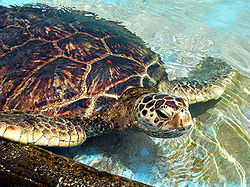 |
| Chelydridae Chelydridae Chelydridae is a family of turtles which has seven extinct and two extant genera. The extant genera are Chelydra the snapping turtles, and its larger relative Macrochelys, of which the Alligator Snapping Turtle is the only species. Both are endemic to the Western Hemisphere... Gray John Edward Gray John Edward Gray, FRS was a British zoologist. He was the elder brother of George Robert Gray and son of the pharmacologist and botanist Samuel Frederick Gray .... , 1831 |
2 | Snapping turtles | Alligator snapping turtle Alligator Snapping Turtle The alligator snapping turtle is one of the largest freshwater turtles in the world. It is not closely related to, but is often associated with the common snapping turtle. They are the sole living member of the genus Macrochelys--while common snappers are in the genus Chelydra... (Macrochelys temminckii) |
 |
| Dermatemydidae Gray John Edward Gray John Edward Gray, FRS was a British zoologist. He was the elder brother of George Robert Gray and son of the pharmacologist and botanist Samuel Frederick Gray .... , 1870 |
1 | Central American river turtle | Central American river turtle (Dermatemys mawii) | 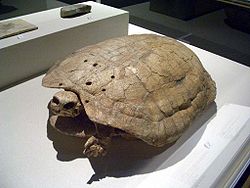 |
| Dermochelyidae Dermochelyidae Dermochelyidae is a family of turtles which has eight extinct and one extant genera.-Classification of known genera:*Subfamily Desmatochelyinae** Corochelys ** Desmatochelys *Subfamily Allopleuroninae ** Allopleuron ** Eosphargis... Fitzinger Leopold Fitzinger Leopold Joseph Franz Johann Fitzinger was an Austrian zoologist.Fitzinger was born in Vienna and studied botany at the university of Vienna under Nikolaus Joseph von Jacquin... , 1843 |
1 | Leatherback sea turtle | Leatherback sea turtle Leatherback Sea Turtle The leatherback sea turtle is the largest of all living sea turtles and the fourth largest modern reptile behind three crocodilians. It is the only living species in the genus Dermochelys. It can easily be differentiated from other modern sea turtles by its lack of a bony shell. Instead, its... (Dermochelys coriacea) |
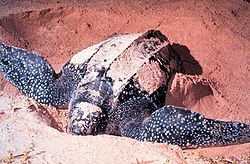 |
|-
|Emydidae
Emydidae
Emydidae, commonly called the pond turtles or marsh turtles, is a family of turtles. Previously, several species of Asian box turtle were classified in the family. However, revised taxonomy has separated them to a different family. Now, Emydidae, with the exception of two species of pond turtle,...
Rafinesque
Constantine Samuel Rafinesque-Schmaltz
Constantine Samuel Rafinesque-Schmaltz, as he is known in Europe, was a nineteenth-century polymath who made notable contributions to botany, zoology, the study of prehistoric earthworks in North America and Mesoamerican ancient linguistics.Rafinesque was eccentric, and is often portrayed as an...
, 1815||12||Pond or water turtles||Red-eared slider
Red-eared slider
The red-eared slider is a semiaquatic turtle belonging to the family Emydidae. It is a subspecies of pond slider. It is the most popular pet turtle in the United States and also popular in the rest of the world...
(Trachemys scripta elegans)||

|Geoemydidae
Geoemydidae
Geoemydidae is the largest and most diverse family in the order Testudines with about 70 species. It includes the Eurasian pond and river turtles and Neotropical wood turtles.-Characteristics:...
Theobald
William Theobald
William Theobald was a malacologist and naturalist on the staff of the Geological Survey of India in Burma. That organization then covered Burma, as it was at the time still a part of British India....
, 1868||24||Asian river, leaf, roofed or Asian box turtles||Malayan box turtle
Cuora amboinensis
The Amboina box turtle , or southeast Asian box turtle is a species of Asian box turtle.It is found in the Nicobar Islands, eastern India , Bangladesh, Myanmar, Thailand, Cambodia, Laos, central and southern Vietnam, West Malaysia, Singapore, Philippines , Indonesia The Amboina box turtle (Cuora...
(Cuora amboinensis)||

|Kinosternidae
Kinosternidae
Kinosternidae is a family of mostly small turtles that includes the mud turtles and musk turtles. The family Kinosternidae contains 25 species within 4 genera, but taxonomic reclassification is an ongoing process so many sources vary on the exact numbers of species and subspecies...
Agassiz
Louis Agassiz
Jean Louis Rodolphe Agassiz was a Swiss paleontologist, glaciologist, geologist and a prominent innovator in the study of the Earth's natural history. He grew up in Switzerland and became a professor of natural history at University of Neuchâtel...
, 1857||4||Mud or musk turtles||Common musk turtle
Sternotherus odoratus
Sternotherus odoratus is a species of small turtle native to southeastern Canada and much of the Eastern United States. It is also known as the common musk turtle or stinkpot due to its ability to release a foul musky odor to deter predation...
(Sternotherus odoratus)||

|Platysternidae
Gray
John Edward Gray
John Edward Gray, FRS was a British zoologist. He was the elder brother of George Robert Gray and son of the pharmacologist and botanist Samuel Frederick Gray ....
, 1869 ||1||Big-headed turtle||Big-headed turtle
Big-headed Turtle
The big-headed turtle is a species of turtle in the family Platysternidae.-Background:Previously considered a distinct family placed on occasion in "Kinosternoidea", it was later moved to the Emydidae. With the Geoemydidae being split off from these, it seems wisest to reinstate, at least for the...
(Platysternon megacephalum)||

|-
|Testudinidae
Batsch
August Batsch
Dr August Johann Georg Karl Batsch was a German naturalist. He was a recognised authority on mushrooms, and also described new species of ferns, bryophytes, and seed plants.- Life and career :...
, 1788||12||Tortoises||Aldabra giant tortoise
Aldabra Giant Tortoise
The Aldabra giant tortoise , from the islands of the Aldabra Atoll in the Seychelles, is one of the largest tortoises in the world....
(Geochelone gigantea)||

|Trionychidae
Trionychidae
Trionychidae is a taxonomic family which comprises a number of turtle genera commonly known as softshells. They are also sometimes called pancake turtles. Softshells consist of some of the world's largest fresh water turtles, though many can adapt to living in highly brackish areas. Members of this...
Fitzinger
Leopold Fitzinger
Leopold Joseph Franz Johann Fitzinger was an Austrian zoologist.Fitzinger was born in Vienna and studied botany at the university of Vienna under Nikolaus Joseph von Jacquin...
, 1826||14||Softshell turtles||Spiny softshell turtle
Spiny Softshell Turtle
The Spiny softshell turtle is a species of softshell turtle, one of the largest freshwater turtle species in North America...
(Apalone spinifera)||

|-
|colspan="5" align="center" |Pleurodira
Pleurodira
The Pleurodira are one of the two living suborders of turtles, the other being the Cryptodira. In many cases in the nomenclature of animals, ranks such as suborder are considered of little importance apart from nomenclatural or taxonomic reasons. However, this is not the case with the suborders of...
– 3 families, 16 genera, over 60 species
|-
!Family!!Genera!!Common names!!Example species!!Example image
|-
|Chelidae
Chelidae
The Chelidae are one of the three living families of the turtle suborder Pleurodira and are commonly called the Austro-South American Side Neck turtles. The Family is distributed in Australia, New Guinea, parts of Indonesia and throughout most of South America. It is a large family of turtles with...
Gray
John Edward Gray
John Edward Gray, FRS was a British zoologist. He was the elder brother of George Robert Gray and son of the pharmacologist and botanist Samuel Frederick Gray ....
, 1831 ||15||Austro-American sideneck turtles||Common snakeneck turtle
Common snakeneck turtle
The eastern long-necked turtle , also known as the eastern snake-necked turtle, common snake-necked turtle or common long-necked turtle, has as its most distinctive feature its extremely long neck. In some cases, this turtle's neck can be as long as its carapace...
(Chelodina longicollis)||

|Pelomedusidae
Pelomedusidae
Pelomedusidae is a family of freshwater turtles, native to eastern and southern Africa. They range in size from to in shell length, and are generally roundish in shape...
Cope
Edward Drinker Cope
Edward Drinker Cope was an American paleontologist and comparative anatomist, as well as a noted herpetologist and ichthyologist. Born to a wealthy Quaker family, Cope distinguished himself as a child prodigy interested in science; he published his first scientific paper at the age of nineteen...
, 1868 ||2||Afro-American sideneck turtles||African helmeted turtle
African helmeted turtle
The African helmeted turtle or Marsh terrapin , is typically a rather small turtle with most individuals being less than 87.9 cm in carapace length, but one has been recorded with a carapace length of 132.5 cm. it has an black or brown carapace . The tops of the tail and limbs are a...
(Pelomedusa subrufa)||

|Podocnemididae
Podocnemididae
Podocnemididae is a family of turtles native to Madagascar and northern South America. They are side-necked turtles , which means they do not retract their heads backwards, but hide it sideways....
Gray
John Edward Gray
John Edward Gray, FRS was a British zoologist. He was the elder brother of George Robert Gray and son of the pharmacologist and botanist Samuel Frederick Gray ....
, 1869 ||3||Madagascar big-headed, Big-headed Amazon River turtle and South American sideneck river turtles||Madagascar big-headed turtle (Erymnochelys madagascariensis)||

|}

